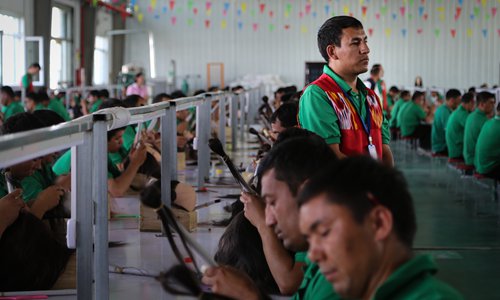HOME >> BUSINESS
China's manufacturing PMI falls amid global slowdown
By Chi Jingyi Source:Global Times Published: 2019/10/31 20:28:41

Local workers busy working at a shoe-making production line in Hotan, Northwest China's Xinjiang Uyghur Autonomous Region. Photo: Chen Qingqing/GT
China's Purchasing Managers' Index (PMI) for the manufacturing sector slid to 49.3 in October from 49.8 recorded for the previous month, the National Bureau of Statistics (NBS) said.
Analysts said the larger-than-expected decline reflected seasonal factors and rising downward pressure on the economy. However, China's economic growth will remain stable at a medium-high pace, they said.
A PMI reading above 50 indicates expansion, while a reading below reflects contraction.
Zhao Qinghe, senior statistician of the NBS, on Thursday said that the drop in the PMI also reflected weakness in foreign economies.
"Manufacturing PMIs fell in all major economies," Liu Jianying, an associate research fellow at the Chinese Academy of International Trade and Economic Cooperation of the Ministry of Commerce, told the Global Times on Thursday. Those declines "show that the global economy is going down."
The US' manufacturing PMI fell sharply in September to 47.8 from 49.1 in August, its lowest level since 2009, and the eurozone's manufacturing PMI was 45.7 in the same month, its lowest level since October 2012.
Liu said that the growth potential of the Chinese economy remains stable. The economy is moving steadily toward high-quality development as China's GDP grew 6.2 percent year-on-year in the first three quarters - the fastest growth of all major economies globally.
High-technology manufacturing, equipment manufacturing and consumption-related sectors remained in the expansion zone.
Zhao noted that continued progress is being achieved in industrial transformation and upgrading, and business confidence remains stable.
The production indexes of 13 sectors were in the expansion zone, from a total of 21 surveyed sectors. Industries including textiles, chemical fibers, rubber and plastic, special equipment and computer communications equipment fell into the high boom range above 55.0.
Liu Xuezhi, a senior economist at the Bank of Communications, forecast possible further declines for the producer price index (PPI), as purchase and factory prices have dropped significantly.
"There is downward pressure on the economy but there is no risk of a 'hard landing' scenario. China needs to step up counter-cyclical regulation and focus on expanding domestic demand to offset the low growth of the global economy."
In October, the non-manufacturing PMI was 52.8, having fallen 0.9 points from the previous reading, indicating an overall expansion trend in the non-manufacturing sector though at a slower pace, said the NBS.
"The structural transformation continues, with the size and share of non-manufacturing industries gradually increasing. The internal structure of the manufacturing industry is also being optimized, and the proportion of the high-technology manufacturing industry is increasing," the economist noted.
The rapid expansion of the aviation, railway, courier, banking and insurance sectors, with each sub-index above 65, indicated that the business confidence of service companies in market development had been boosted, according to the NBS.
"During the transition of China's economic structure, it is normal to see GDP growth decline. China can still maintain a medium-high growth rate as the main driving force for economic stability is consumption, in which China has great growth potential," said Liu Xuezhi.
Newspaper headline: Manufacturing PMI falls amid global slowdown; companies still confident
Posted in: INDUSTRIES,ECONOMY,BIZ FOCUS